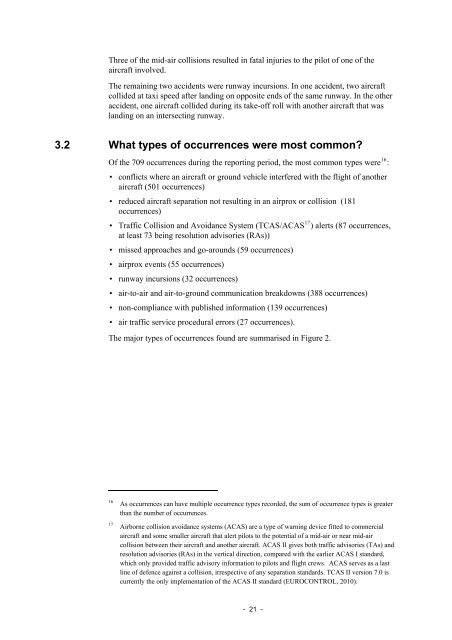Safety in the vicinity of non-towered aerodromes - Australian ...
Safety in the vicinity of non-towered aerodromes - Australian ...
Safety in the vicinity of non-towered aerodromes - Australian ...
You also want an ePaper? Increase the reach of your titles
YUMPU automatically turns print PDFs into web optimized ePapers that Google loves.
Three <strong>of</strong> <strong>the</strong> mid-air collisions resulted <strong>in</strong> fatal <strong>in</strong>juries to <strong>the</strong> pilot <strong>of</strong> one <strong>of</strong> <strong>the</strong><br />
aircraft <strong>in</strong>volved.<br />
The rema<strong>in</strong><strong>in</strong>g two accidents were runway <strong>in</strong>cursions. In one accident, two aircraft<br />
collided at taxi speed after land<strong>in</strong>g on opposite ends <strong>of</strong> <strong>the</strong> same runway. In <strong>the</strong> o<strong>the</strong>r<br />
accident, one aircraft collided dur<strong>in</strong>g its take-<strong>of</strong>f roll with ano<strong>the</strong>r aircraft that was<br />
land<strong>in</strong>g on an <strong>in</strong>tersect<strong>in</strong>g runway.<br />
3.2 What types <strong>of</strong> occurrences were most common?<br />
Of <strong>the</strong> 709 occurrences dur<strong>in</strong>g <strong>the</strong> report<strong>in</strong>g period, <strong>the</strong> most common types were 16 :<br />
• conflicts where an aircraft or ground vehicle <strong>in</strong>terfered with <strong>the</strong> flight <strong>of</strong> ano<strong>the</strong>r<br />
aircraft (501 occurrences)<br />
• reduced aircraft separation not result<strong>in</strong>g <strong>in</strong> an airprox or collision (181<br />
occurrences)<br />
• Traffic Collision and Avoidance System (TCAS/ACAS 17 ) alerts (87 occurrences,<br />
at least 73 be<strong>in</strong>g resolution advisories (RAs))<br />
• missed approaches and go-arounds (59 occurrences)<br />
• airprox events (55 occurrences)<br />
• runway <strong>in</strong>cursions (32 occurrences)<br />
• air-to-air and air-to-ground communication breakdowns (388 occurrences)<br />
• <strong>non</strong>-compliance with published <strong>in</strong>formation (139 occurrences)<br />
• air traffic service procedural errors (27 occurrences).<br />
The major types <strong>of</strong> occurrences found are summarised <strong>in</strong> Figure 2.<br />
16<br />
As occurrences can have multiple occurrence types recorded, <strong>the</strong> sum <strong>of</strong> occurrence types is greater<br />
than <strong>the</strong> number <strong>of</strong> occurrences.<br />
17 Airborne collision avoidance systems (ACAS) are a type <strong>of</strong> warn<strong>in</strong>g device fitted to commercial<br />
aircraft and some smaller aircraft that alert pilots to <strong>the</strong> potential <strong>of</strong> a mid-air or near mid-air<br />
collision between <strong>the</strong>ir aircraft and ano<strong>the</strong>r aircraft. ACAS II gives both traffic advisories (TAs) and<br />
resolution advisories (RAs) <strong>in</strong> <strong>the</strong> vertical direction, compared with <strong>the</strong> earlier ACAS I standard,<br />
which only provided traffic advisory <strong>in</strong>formation to pilots and flight crews. ACAS serves as a last<br />
l<strong>in</strong>e <strong>of</strong> defence aga<strong>in</strong>st a collision, irrespective <strong>of</strong> any separation standards. TCAS II version 7.0 is<br />
currently <strong>the</strong> only implementation <strong>of</strong> <strong>the</strong> ACAS II standard (EUROCONTROL, 2010).<br />
- 21 -
















